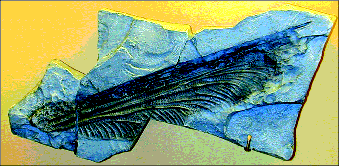17. Convergent Evolution or Intelligent Design?
When the same complex capability is found in similar organisms, evolutionists say it evolved from a common ancestor. When the same complex capability is found in dissimilar organisms evolutionists say that convergent evolution explains it. With such flexible definitions, evolution can explain many things and not be falsified.
For example, wings and flight occur in some birds, insects, and mammals (bats). Pterosaurs, an extinct reptile, also

Figure 9: Dragonfly Wing. This delicate,1 1/2-foot-long wing must have been buried rapidly and evenly to preserve its details. Imagine the size of the entire dragonfly!

Figure 10: Fossil of Fish Swallowing Fish. Burial and fossilization must have been quite rapid to have preserved a fish in the act of swallowing another fish. Thousands of such fossils have been found.
Concluding that a miracle—or any extremely unlikely event—happened once requires strong evidence or faith; claiming that a similar “miracle” happened repeatedly requires either incredible blind faith or a cause common to each event, such as a common designer.
Furthermore, it is illogical to maintain that similarities between different forms of life always imply a common ancestor;c such similarities may imply a common designer and show efficient design. In fact, where similar structures are known to be controlled by different genesd or are developed from different parts of embryos,e a common designer is a much more likely explanation than evolution.